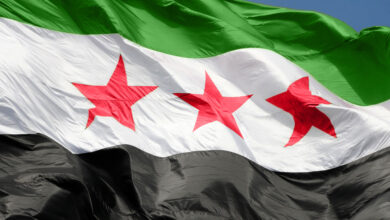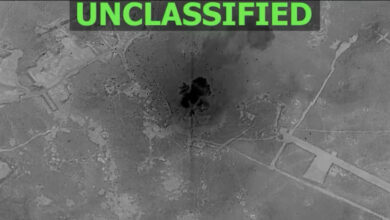
DAMASCUS — The Palestinian camps of Yarmouk, Tadamon and Falesteen lie on the southwest outskirts of Damascus. Mountains of piled stones and trash surrounding the military checkpoints prevent cars and civilians from entering. Snipers strike from surrounding rooftops. A man lies on the ground, shot dead at the entrance of the camp.
With no place to go, women continue to walk back to the camps despite the shootings, carrying bags on their head, trying to reach their homes. Only those living near Yarmouk’s entrance would find their houses still standing.
Inside Tadamon and Falesteen, some civilians remain trapped under sniper fire and rely on three local associations whose members risk their lives to distribute food and diesel.
The south strip of the camp is still under the control of the Free Syrian Army (FSA). Meanwhile, President Bashar al-Assad’s Syrian army continues to gain ground on the northern side.
As with any attack in Syria, testimonies give rise to differing stories blaming one side or the other.
Among a puzzle of eyewitnesses, Yannan sums up the most plausible version of the attack.
“Thousands of FSA men flooded into the camps urging us to leave. Then planes appeared and bombed Al-Husseiny Mosque and a nearby school full of refugees. Everything became chaotic, a lot of shouting, and people rushed into the streets.”
As for the logistics of the operation, Mazen, a member of the Palestinian Local Coordination Committee, expresses his disappointment with the FSA.
“They did not coordinate the operation with us, nor did they inform us about it, which put civilians at risk and hindered the success of the whole operation,” he says.
The attack on Yarmouk on 16 December left 25 civilians dead and forced almost 100,000 Palestinians to flee either to Damascus or to other Palestinian camps in neighboring Lebanon.
The United Nations Relief and Works Agency for Palestinian Refugees estimates that as many as 20,000 Palestinians have fled to Lebanon since the beginning of the war. Half of them arrived at Ein al-Helwe, in south Lebanon, where 75,000 refugees already live and have to scrape by in the space of two square kilometers.
Ein al-Helwe received the first wave of refugees from Syria last August when Yarmouk was first attacked. Nevertheless, those refugees were able to return to Syria unlike those who fled in December and have no home to return to.
Yannan’s elderly mother recounts the attack on the camps as her latest among a long list of escapes. In 1948, she fled what was then Palestine when she was 15, with a 9-month-old who had already lost his father.
In seven years, she moved from Iraq to Jordan to Deraa in south Syria before settling in Yarmouk. Now, her son-in-law has decided to move the family to Ein al-Helwe camp where they will be more secure.
With the arrival of thousands of refugees from Syria, Ein al-Helwe represents the sores of the Syrian conflict. A few days after Yannan’s family arrival, a 30-year-old Syrian refugee and father-of-four committed suicide by hanging himself.
An indiscriminate attack on Palestinian camps by the Syrian regime, an ally of the Palestinian political elite, does not make sense. Compared to the Palestinian camps in Jordan and Lebanon, the half a million Palestinians in Syria are far more integrated into society.
Choosing sides
Amid war, Palestinians have to choose between two polarized sides even if this entails division among them. The Palestinian faction Qiada al-Ama, or General Command, led by Ahmed Jibril, is one of the most fervent supporters of Assad’s regime.
Jibril has armed young Palestinians forming popular committees within the camps and fighting alongside the Syrian army. A high-ranking official from the Popular Front for the Liberation of Palestine condemns Jibril’s move.
“There was an attempt to assassinate Jibril at the beginning of the uprising, but he managed to escape and leave the camps to later return with his armed men,” the official says. “Now there are 6,500 armed men fighting in Yarmouk.”
Jibril was the first to push Palestinians to take sides in the Syrian war. On 5 June 2011, and with the support of the Syrian regime, he orchestrated a demonstration along the Golan border against Israel. The Israeli army killed 23 of the demonstrators.
The next day, thousands of Palestinians demonstrated in front of Jibril’s headquarters in Yarmouk, accusing him and the Palestinian factions of manipulating young Palestinians to side with the regime’s interests.
Omar, a member of the Palestinian Local Coordination Committee in Yarmouk, estimates that Jibril now has only several hundred armed men under his command.
“There were around 2,000 armed men in charge of protecting Yarmouk, fighting for the sake of civilians against both rebels and the Syrian army. When Jibril openly took part in the Syrian conflict, many defected from Qiada al-Ama and joined the rebels,” recounts Omar.
Most of the Palestinian refugees complain about looting and brutality from by both sides and, as with displaced Syrians, they only seek a safe haven.
Mazen conceives Palestinians and Syrians living in Syria as one people, but mentions how Palestinians can benefit from the Syrian revolution.
“We are trapped among many sides: Jibril, the Palestinian factions, the Syrian regime, the FSA and the Syrian army. Among the FSA in Yarmouk, there are professionals, but radicals as well as Shabiha [pro-regime paramilitaries].”
“Once the regime falls, Syria will be free, and, as Palestinians, we will be able to get rid of Palestinian factions. Palestinian political elites are no more than an empty shell, corrupt and without supporters. As for the Syrian regime, it never helped Palestinians other than rhetorically.”
“The most chanted slogan in Palestinian demonstrations remains: ‘Sons of the haram, selling the Golan’ [in reference to the Syrian regime],” Mazen says.
Nevertheless, the Palestinian Local Coordination Committee opposes Palestinians wielding weapons against either Syrians or Palestinians.
Meanwhile, Palestinian supporters of Hamas have decided to fight against the Syrian army alongside the Islamist groups among the rebels. With different Palestinian factions aligning on opposite sides of the Syrian divide, they at times find themselves firing at each other amid clashes between the rebels and the Syrian army.
After several days of negotiations, and with most of Tadamon and Falesteen having been destroyed, the army, rebels and Palestinians reached an agreement whereby the rebels would withdraw toward Yelda, south of Yarmouk. No document was signed.
For a young rebel fighter who prefers to remain anonymous, this agreement is bound to fail: “We are trying to reach Damascus and we cannot do it from the north where the army is very present and mountains hinder the path. We must do it from the south of the city, from east to west: from Joubar to Kafer Soussa.
“Yarmouk is the last piece of the south and the best entrance to the city because, contrary to the rest, it is not separated by the highway but offers direct access to Damascus and to bystreets where fighters can overcome their inferiority in number and weaponry.”
“It is a key entry for the rebels’ strategy,” the rebel figher says.
This strategic reality explains why the Syrian army reacted so furiously — cutting the rebels’ advance by bombing the camps.
Regional events also play a role. Some Palestinian youth see the rise of the Muslim Brotherhood in Egypt and Hamas in Gaza as a sign that they could recover Palestine by armed means.
Many youth are joining them with this dream in view. Small groups of the young men from Ein al-Helwe are taking part in the fight in Syria alongside Islamist rebels. At least three funerals have already taken place in Ein al-Helwe for the bodies returned to the camp as martyrs, including Jamal Suleiman, the nephew of a leading member of the Islamist Usbat Al-Ansar.




